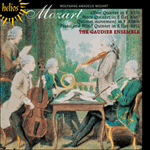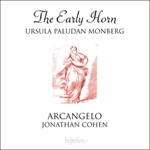Wolfgang Amadeus Mozart’s Horn Quintet in E flat major is scored for the unusual string combination of one violin, two violas and a cello, giving it a deeper sonority than that of a regular string quartet (two violins, one viola and a cello). The André edition (1802/3) was one of the first published with a horn part—two previous editions re-scored the original horn part within the instrumentation of a string quintet—and it omits several bars that were subsequently reinserted in later editions. André also put some of the horn’s low notes an octave up so that the part would better suit a specialist of the high register. It is thought that Mozart’s horn player, Joseph Leitgeb (1732-1811), found playing low notes more difficult as he aged, so perhaps André obtained a simplified copy via Leitgeb, or from another high horn player familiar with the work. However, there is no known autograph of the score, and the later editions are guided by scholarship rather than the original text.
from notes by Andrew Clark © 2020
Le Quintette avec cor en mi bémol majeur de Wolfgang Amadeus Mozart est écrit pour une combinaison de cordes inhabituelle, un violon, deux altos et un violoncelle, ce qui donne une sonorité plus profonde que celle d’un quatuor à cordes normal (deux violons, un alto et un violoncelle). L’édition André (1802/3) utilisée dans cet enregistrement fut la première publiée avec une partie de cor—deux éditions antérieures réécrivent la partie de cor originale au sein de l’instrumentation d’un quintette à cordes—et omet plusieurs mesures qui furent ensuite réinsérées dans les éditions ultérieures. André place aussi certaines notes graves du cor à l’octave supérieure pour que cette partie convienne mieux à un spécialiste du registre aigu. On pense que le corniste de Mozart, Joseph Leitgeb (1732-1811), trouvait les notes graves plus difficiles en prenant de l’âge, et André obtint donc une copie simplifiée par l’intermédiaire de Leitgeb ou d’un autre instrumentiste spécialisé dans le registre aigu qui connaissait cette œuvre. Toutefois, il n’y a pas d’autographe connu de la partition et les éditions ultérieures reposent davantage sur l’érudition que sur le texte original.
extrait des notes rédigées par Andrew Clark © 2020
Français: Marie-Stella Pâris
Das Hornquintett Es-Dur von Wolfgang Amadeus Mozart ist für die ungewöhnliche Streicherbesetzung mit einer Violine, zwei Bratschen und Violoncello geschrieben, die ihm einen tieferen Klang verleiht als den eines gewöhnlichen Streichquartetts mit zwei Violinen, einer Bratsche und Cello. Die bei André erschienene Ausgabe von 1802/3, die der Aufnahme zugrunde liegt, war die erste mit einer Hornstimme; frühere Ausgaben waren für Streichquintett umgeschrieben worden. Sie lässt einige Takte aus, die in späteren Ausgaben wieder eingefügt wurden. Außerdem transponierte André manche tiefe Töne der Hornstimme eine Oktave nach oben, sodass die Stimme für einen Spezialisten für hohes Horn besser liegt. Man nimmt an, dass es dem mit Mozart befreundeten Hornisten Joseph Leitgeb (1732-1811) mit zunehmendem Alter schwerer fiel, tiefe Töne zu spielen. Vielleicht lag André also eine für Leitgeb oder auch einen anderen Spieler vereinfachte Version vor. Allerdings fehlt uns das Manuskript; spätere Fassungen folgen deswegen keinem Originaltext, sondern philologischen Erwägungen.
aus dem Begleittext von Andrew Clark © 2020
Deutsch: Friedrich Sprondel



 Mozart: Oboe Quartet, Horn Quintet & other works
Mozart: Oboe Quartet, Horn Quintet & other works The Early Horn
The Early Horn
